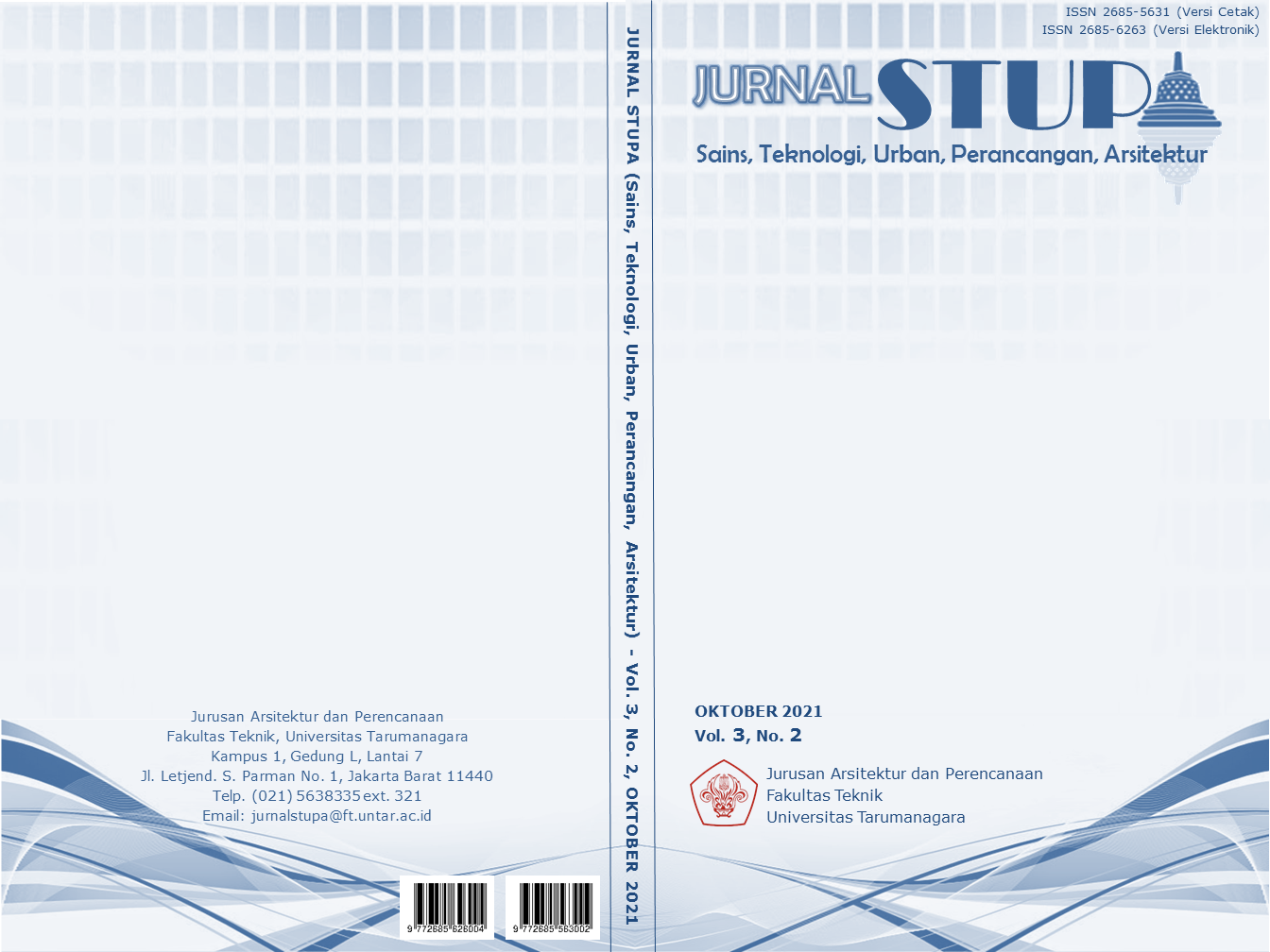FASILITAS PEMULIHAN ENERGI PLASTIK DENGAN KONTEKS PERKOTAAN DAN KOMUNITAS
Main Article Content
Abstract
The plastic energy recovery facility is an industrial facility that has a function in processing plastic waste into energy in the form of fuel oil. The word energy recovery itself initially did not only discuss material waste, but also an operating system that minimizes the amount of energy wasted in a process. This system is often used in the form of technology to reduce the amount of wasted energy waste and the waste can be in the form of plastic as well. However, in the process of processing plastic waste into energy, it is important to know that energy is needed which will eventually be wasted. The wasted energy can be in the form of heat, light, electricity, water, and air. This wasted energy creates a problem where the plastic waste treatment facility itself also ends up generating too much energy waste in its system. If left unchecked, this energy waste will make plastic processing facilities useless because how much energies are wasted in processing plastic waste. Therefore, in the design, a design method in the form of energy recovery is applied in the building system. This energy recovery is broadly implemented in three ways, namely applying a recycle system to the energy used, energy conservation, and through energy harvesting from nature by harvesting energy from nature and conserving energy, it means that energy consumption in buildings can be done more sustainably and efficiently. Energy use in buildings can not only depend on the energy supply system from the management sector but can also utilize the energy that exists in nature. Thus, the design of the plastic energy recovery facility can work in a more sustainable and environmentally sensitive system.
Keywords: energy conservation; energy harvesting; energy recovery; plastic energy recovery; recycle energy; waste
Abstrak
Fasilitas pemulihan energi plastik merupakan sebuah fasilitas industri yang memiliki fungsi dalam mengolah limbah plastik menjadi energi berupa minyak bahan bakar. Kata pemulihan energi sendiri awalnya tidak hanya membahas mengenai limbah material saja, tapi juga sebuah sistem operasi yang meminimalisir jumlah energi yang terbuang dalam suatu proses. Sistem ini seringkali digunakan dalam bentuk teknologi untuk mengurangi jumlah limbah energi yang terbuang dan limbah tersebut dapat berupa plastik juga. Namun di dalam proses fasilitas pengolahan limbah plastik menjadi energi, perlu diketahui bahwa diperlukan energi yang akhirnya akan terbuang. Energi yang terbuang itu bisa berupa panas, cahaya, listrik, air, dan udara. Terbuangnya energi tersebut memunculkan masalah dimana fasilitas pengolahan limbah plastik sendiri akhirnya juga menghasilkan limbah energi dalam sistemnya. Jika dibiarkan, limbah energi ini akan membuat fasilitas pengolahan plastik menjadi hal yang sia-sia dikarenakan banyaknya jumlah energi yang dibuang untuk memproses limbah plastik. Oleh karena itu dalam perancangan, diterapkan metode perancangan berupa pemulihan energi yang diterapkan dalam sistem bangunan. Pemulihan energi ini secara garis besar diterapkan dalam tiga cara, yaitu menerapkan sistem daur ulang pada energi yang dipakai, konservasi energi, dan melalui pemanenan energi dari alam. Dengan pemanenan energi dari alam dan konservasi energi, berarti konsumsi energi pada bangunan bisa dilakukan dengan lebih berkelanjutan dan efisien. Penggunaan energi pada bangunan bisa tidak hanya bergantung dari sistem pasokan energi dari sektor pengelola tapi juga bisa memanfaatkan energi yang ada di alam. Dengan demikian, rancangan fasilitas pemulihan energi plastik dapat bekerja dalam sistem yang lebih berkelanjutan dan peka terhadap lingkungan.
Article Details
References
David S. (2008). 'Recycling' Energy Seen Saving Companies Money
Guler U. , Sendi M.S.E. , Ghovanloo M. (2017). Dual-mode passive rectifier for wide-range input power flow, IEEE 60th International Midwest Symposium on Circuits and Systems (MWSCAS)
Ha?im Altan, K. Tabet Aoul (2016). ZEMCH: Toward the Delivery of Zero Energy Mass Custom Homes
International Union of Pure and Applied Chemistry (2009). Compendium of Chemical Terminology. p. 1824.
Pedata L. (2011). Environmental design IED Master
Valerie L. Shulman (2011). Waste
Waste Tire Oil, Waste Plastic Recycling Pyrolysis Plant, diunduh pada 22 Juli 2021, <https://www.wastetireoil.com/Pyrolysis_plant/waste_plastic_pyrolysis_plant/waste_plastic_pyrolysis_plant_1266.html#Technical>
Yaniv R. (2012) Building beyond: a trade school in Swaziland, Africa, passive design techniques



